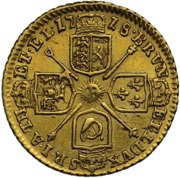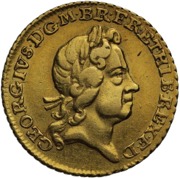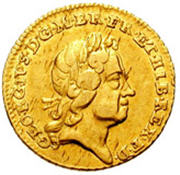 The 1718 Quarter Guinea - George I
The 1718 Quarter Guinea - George IQuarter Guineas were only minted in two years - 1718 and 1762. Due to their small size and yet comparatively high value, they were not very popular at the time.
In 1718 Sir Isaac Newton was Master of the Mint. At that time silver prices were skyrocketing and the silver coins of the time were actually worth more in silver than face value. Thus, silver coins were being melted down for their silver leaving a large shortage of small denomination coins.
You can read more details in our article The Quarter-Guinea and Other Problems.
Newton's response was to make a gold equivalent to the silver crown (5 shillings). A Quarter-Guinea would be worth and 5 shillings and 3 pence.
The new coin followed the same design and proportions of a full guinea, including the verbose legend. Problem was it was just 16mm in diameter and a weight of just over 2.13g. Considering it was probably worth fifty pounds plus in today's values it was a risky coin to have in your pocket and easily lost. The Quarter Guinea wasn't made again for 44 years.
The Reverse shows crowned cruciform coats-of-arms with sceptres in the quarters and a Sun in the centre. Legend around with date at top.
 The Obverse shows the laurel head of King George I.
The Obverse shows the laurel head of King George I.Images used by permission of The Royal Mint
Mintage: 37,380 (may include coins in sets)
Minted at The Royal Mint
Below are some coins currently being offered on eBay. As an eBay Partner, We may be compensated if you make a purchase.
 George I was King of Great Britain and Ireland from 1 August 1714 until his death, and ruler of the Duchy and Electorate of Brunswick-Lüneburg in the Holy Roman Empire from 1698. He was born in Hanover and was second-cousiin to Queen Anne, so it was only the banning of Catholics taking the throne which allowed him to become King.
George I was King of Great Britain and Ireland from 1 August 1714 until his death, and ruler of the Duchy and Electorate of Brunswick-Lüneburg in the Holy Roman Empire from 1698. He was born in Hanover and was second-cousiin to Queen Anne, so it was only the banning of Catholics taking the throne which allowed him to become King.During George's reign, more power was ceeded to Parliament and Sir Robert Walpole was probably the first de-facto Prime Minister. George was succeeded by his son, George II.
The regnal years for George I coins were:
1716:SECVNDO; 1717:TERTIO; 1718:QUINTO; 1720:SEXTO; 1723:DECIMO; 1726:DECIMO TERTIO.
The Guinea is a famous British gold coin minted between 1663 and 1814. The coin was originally created as a one pound coin (20 shillings) but is better known as being worth One Pound and One Shilling (21 shillings).
After the English Civil War, King Charles II introduced new coinage. A gold coin, approximately a quarter of an ounce, was issued and for the first time it was not hammered. Made by machine using gold from the Guinea Coast of West Africa the coin probably became the most important coin of the realm.
Originally 20 shillings, the coin actually fluctuated with the gold price, at times being as high as 30 shillings. In 1717 the Guinea became fixed at 21 shillings (in today’s money that is £1.05). Other coins of the family were also minted, such as half-guinea, two-guinea and five-guinea.
The design of gold guinea changed dramatically over the years, from depictions of crowned cruciform shields to the ‘Spade’ shaped crowned shields of arms.
In the Great Recoinage of 1816 the Guinea was replaced by the Pound and the Sovereign became the gold coin in use. The last guinea was issued during the reign of King George III in 1813. That particular coin is known as a ‘Military’ guinea, as it was specially struck to pay British troops at the time of the Napoleonic Wars.
Long after the Guinea was retired the name continued to be used, especially for prestige purchases intended for the more wealthy. Even now racehorses are still sold in Guineas (the auctioneer traditionally taking the 5p as commission).
Guineas are 25mm in diameter, weigh about 8.38g and are 22 carat gold (91.6%). Prior to 1717 they weighed slightly less (around 8.3g) and were made of 91.34% gold.
Millions of gold guineas were minted and widely circulated, so often turn up in fine to very fine condition. As with all coin types, some years are much rarer than others, such as the 1761 guinea (as it was the first guinea minted during the reign of King George III).
Formed in the reign of Alfred the Great about the year 886, during the period 1279-1812 it was generally referred to as The Tower Mint as it was housed at the Tower of London. The Master of The Royal Mint has included famous figures such as Sir Isaac Newton.
Since 2010 it has operated as Royal Mint Ltd, a company owned by HM Treasury, under an exclusive contract to supply all coinage for the UK although it also produces medals and coins for other countries. It is currently located at Llantrisant, Wales.
The orignal coinage was Pounds, Shillings and Pence but since decimalisation on 15 February 1971, it is £1 = 100p, that is One Pound = 100 pence. The coinage of the UK is also a long history, the Royal Mint being established as long ago as 886AD when coins were hammered. Today there is perhaps 30 billion coins in circulation, and many (numismatic) collectors coins and sets are issued frequently in gold, silver and other metals.








